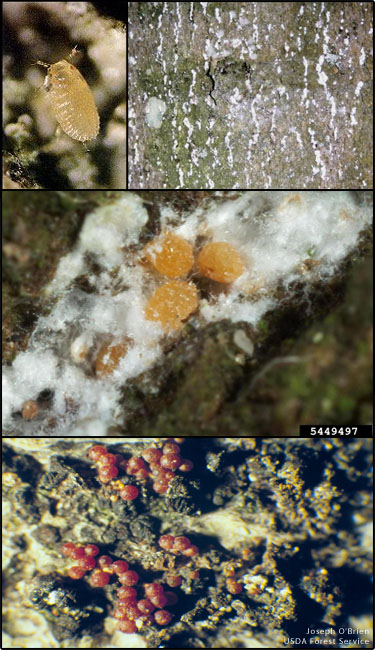Beech bark disease (Neonectria spp.)
 Description: The disease is caused by a combination of the Neonectria fungus and beech scale (Cryptococcus fagisuga).
Description: The disease is caused by a combination of the Neonectria fungus and beech scale (Cryptococcus fagisuga).Identification: Beech scales are yellow, soft-bodied insects that are 0.5 to 1.0 mm long as adults. The Nectria fungus includes 3 types galligena, coccinea and ochroleuca. All produce fruiting bodies called perithecia which are tiny and bright red and occur in clusters on living or dead bark. Each perithecia is filled with sacs of spores.
Habitat: Native to Europe but not actually recorded outside of North America. American beech (Fagus grandifolia) and European beech (Fagus sylvatica). Trees around 25 years old appear to be particularly susceptible.
Reproduction: Spores are produced in fruiting bodies called perithecia that occur in clusters on the bark. The perithecia, are tiny, bright red, and lemon shaped. Each perithecium is filled with elongated sacs, each containing eight spores. Spores are formed asexually or vegetative and mature in the fall.
Impact and Damage: The tiny scale insects, found on the tree trunk and branches, feed on sap in the inner bark. Minute wounds and injuries caused by the scale insects eventually enable the Nectria fungus to enter the tree. The Nectria kills areas of woody tissue, sometimes creating cankers on the tree stem and large branches. Tree mortality occurs three to six years after scales initially infest an area. The largest trees are most susceptible. Scale-infested trees with apparently healthy crowns are a hazard due to beech snap. There are three stages of beech bark disease invasion: the advancing front which refers to stands where trees are infested with beech scale but not the nectria fungus. It can spread roughly 6 miles per year. The next stage is the killing front which refers to stands where beech scale populations are high and nectria infection is abundant. Tree mortality is heavy. The last stage, the Aftermath forest, refers to stand that have experienced the first wave of beech mortality. Residual beech trees are mostly defective and declining. Some large trees remain.
Monitoring and rapid response: Scale insects can be removed by scrubbing a tree with a soft brush, using water from a high pressure nozzle. Normant and horticultural oils are petroleum-based products that cover and suffocate soft-bodied insects such as aphids, spider mites and scales. Currently no effective insecticides have been found. Credits: The information provided in this factsheet was gathered from the The Biology and Management of Beech Bark Disease from the Michigan State University Extension and the Forest Insect and Disease Leaflet #75.
Individual species images that appear with a number in a black box are courtesy of the Bugwood.org network (https://www.invasive.org).Individual photo author credits may not be included due to the small display size of the images and subsequent difficulty of reading the provided text. All other images appear courtesy of Google (https://images.google.com).
Common Name: | Beech bark disease |
Scientific Name: | Neonectria spp. |
Family: | Nectriaceae (Ascomycetous fungi) |
Habit: | Pathogens |
